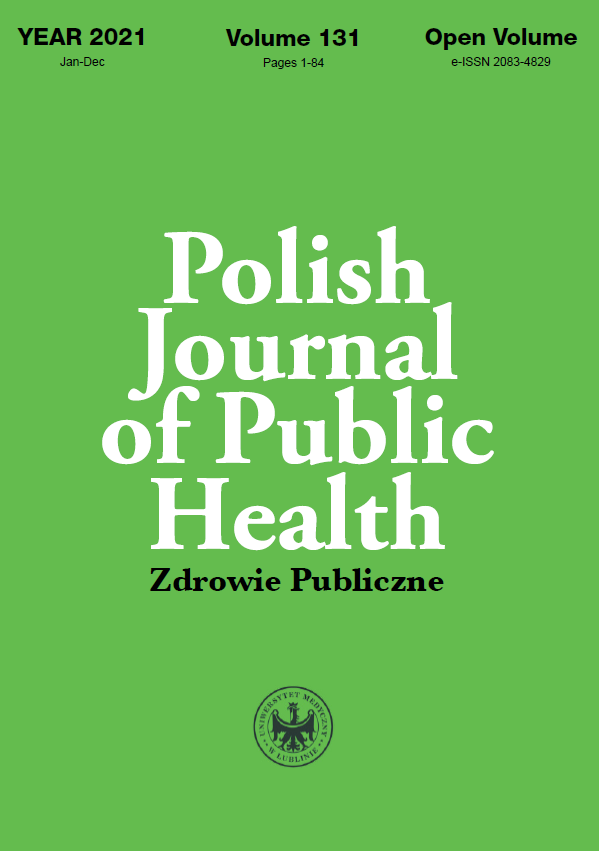Does the use of step counting devices affect the level of physical activity and body mass index of the youth studying in Lublin during COVID-19 pandemic?
DOI:
https://doi.org/10.2478/pjph-2021-0003Keywords:
step counting devices, physical activity, body mass index, students, COVID-19 pandemicAbstract
Introduction. Due to coronavirus disease 2019 (COVID-19) many people give up exercises. International physical activity guidelines recommend 150 minutes per week of moderate- to vigorous-intensity physical activity or 75 minutes at high intensity per week. Healthy adults should take 10,000 steps per day. Wearable devices (smartwatches, step counters, physical activity monitoring applications) have the potential to promote a healthy lifestyle at the time of COVID-19 pandemic. They are accepted by the youth.
Aim. The aim of the study was to find out if using step counting devices affects the level of physical activity and body mass index (BMI) in students.
Material and methods. A total of 303 participants (227 women, 76 men) studying in Lublin, Poland of mean age 19.5 years participated in the study conducted with use of an internet questionnaire.
Results. Before the COVID-19 pandemic their mean BMI was 22.17 kg/m2 and after 9 months of COVID-19–related restrictions it was 22.57 kg/m2. Among the respondents 204 (67.3%) did a physical activity for 50 min 3 times a week in 2019 and 99 (32.7%) did not. In December 2020 there was a significant decrease in the number of students doing physical activity to 128 (42.2%) (p<0.05) and an increase in the number of students who did not do any physical activity to 175 (57.8%) (p<0.05). In 2019 as many as 110 (36.3%) of the respondents used to use step counting devices and 192 (63.7%) did not. In 2020 the number of students using activity tracking devices significantly decreased to 58 (19.2) (p<0.05). The number of students who did not use any step counting device in 2020 was 245 (80.8%).
Conclusion. Due to the COVID-19 pandemic the number of students who don’t do enough physical activity significantly increased. The use of step counting devices helps students in continuing physical activity despite COVID-19-related restrictions.
References
1. Nobile M. THE WHO DEFINITION OF HEALTH: A CRITICAL READING. Med Law. 2014;33(2):33-40. PMID: 27359006.
2. Warburton DE, Bredin SS. Reflections on physical activity and health: What should we recommend? Can J Cardiol. 2016;32(4):495-504.
3. Jansson E, Hagströmer M, Anderssen SA. Fysisk aktivitet – nya vägar och val i rekommendationerna för vuxna. Lakartidningen. 2015;112:DP7W.
4. Piercy KL, Troiano RP, Ballard RM, et al. The physical activity guidelines for Americans. JAMA. 2018;320(19):2020-8.
5. Tudor-Locke C, Craig CL, Brown WJ, et al. How many steps/day are enough? For adults. Int J Behav Nutr Phys Act. 2011;8:79.
6. Polish Journal of Laws. Warsaw, Poland; 2020. Dz.U. 2020.491 (accessed on Dec 28th 2020).
7. Liang J, Xian D, Liu X, et al. Usability study of mainstream wearable fitness devices: Feature analysis and System Usability Scale Evaluation. JMIR Mhealth Uhealth. 2018;6(11):e11066.
8. Nieradko-Iwanicka B. Nutritional assessment of the II-year students of Medical Faculty with Dentistry Division of Medical University in Lublin – pilot study. Fam Med Prim Care Rev. 2014;16 (2):138-9.
9. Holguera RM, Turrión Nieves AI, Rodríguez Torres R, Alonso MC. Relationship of muscle mass determined by DEXA with spirometric results in healthy individuals. Arch Bronconeumol. 2017;53(7):375-80.
10. Warburton DER, Bredin SSD, Health benefits of physical activity: a systematic review of current systematic reviews. Curr Opin Cardiol. 2017;32(5):541-56.
11. Ammar A, Brach M, Trabelsi K, et al. Effects of COVID-19 home confinement on eating behaviour and physical activity: Results of the ECLBCOVID19 International Online Survey. Nutrients. 2020;12(6):1583.
12. Ammar A, Mueller P, Trabelsi K, et al. ECLB-COVID19 Consortium. Psychological consequences of COVID-19 home confinement: The ECLBCOVID19 multicenter study. PLoS One. 2020;15(11):e0240204.
13. Ammar A, Chtourou H, Boukhris O, et al. COVID-19 home confinement negatively impacts social participation and life satisfaction: A worldwide multicenter study. Int J Environ Res Public Health. 2020;17(17):6237.
14. Tophøj KH, Petersen MG, Sæbye C, et al. Validity and reliability evaluation of four commercial activity trackers’ step counting performance. Telemed J E Health. 2018;24(9):669-77.
15. Fokkema T, Kooiman TJ, Krijnen WP, et al. Reliability and validity of ten consumer activity trackers depend on walking speed. Med Sci Sports Exerc. 2017;49(4):793-800.
16. Evenson KR, Goto MM, Furberg RD. Systematic review of the validity and reliability of consumer-wearable activity trackers. Int J Behav Nutr Phys Act. 2015;12:159.
17. Svarre FR, Jensen MM, Nielsen J, Villumsen M. The validity of activity trackers is affected by walking speed: the criterion validity of Garmin Vivosmart® HR and StepWatch™ 3 for measuring steps at various walking speeds under controlled conditions. Peer J. 2020;8:e9381.
18. Tedesco S, Sica M, Ancillao A, et al. Validity Evaluation of the Fitbit Charge2 and the Garmin vivosmart HR+ in free-living environments in an older adult cohort. JMIR Mhealth Uhealth. 2019;7(6):e13084.
19. Graf C, Schlepper S, Bauer C, et al. Feasibility and acceptance of exercise recommendations (10.000 steps a day) within routine German health check (Check-Up 35/GOÄ29)-study protocol. Pilot Feasibility Stud. 2016;2:52.
20. Kalbarczyk M, Mackiewicz-Łyziak J. Physical activity and healthcare costs: Projections for Poland in the context of an ageing population. Appl Health Econ Health Policy. 2019;17(4):523-32.
21. Ezzati M, Riboli E. Behavioral and dietary risk factors for noncommunicable diseases. N Engl J Med. 2013;369(10):954-64.
22. Wojtyniak B, Goryński P. Sytuacja zdrowotna ludności Polski i jej uwarunkowania. Warszawa; Narodowy Instytut Zdrowia Publicznego – Państwowy Zakład Higieny; 2018.
23. Institute for Health Metrics and Evaluation, GBD Compare. [https://vizhub.healthdata.org/gbd-compare/ ](Cited on Dec 29,2020).
Downloads
Published
Issue
Section
License
Copyright (c) 2021 Polish Journal of Public Health

This work is licensed under a Creative Commons Attribution-NonCommercial-NoDerivatives 3.0 Unported License.


